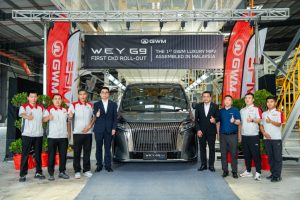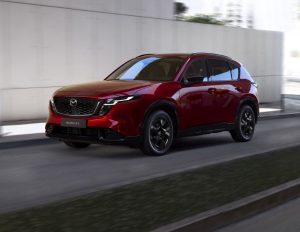Photos by KAMARUL ARIFFIN/The Star
THE all-electric Hyundai Ioniq 6 stands out on the road with its bold, sleek, sporty sedan styling.
Its flowy, aerodynamic design inevitably drew comparisons with a famous German sports car (think Porsche 911) from some of our friends.
Flush door handles add to the style quotient, and the Ioniq 6 has a ultra-low aerodynamic drag coefficient of 0.21.
It’s offered here in four variants. The model initially was launched with a single-motor Max RWD (rear-wheel-drive) and a dual-motor Max AWD (all-wheel drive) with impressive WLTP (or Worldwide Harmonised Light Vehicles Test Procedure) ranges of 614km and 519km respectively. Less than two month later, the initial duo were followed by the lower priced Lite and Plus, which are RWD single motor variants with 429km of range.
The Ioniq 6 is priced on-the-road before insurance at RM289,888 (Max RWD) and RM319,888 (Max AWD). The Lite RWD is going for RM219,888, while the Plus RWD is RM249,888. All prices are inclusive of an eight-year or 160,000km (whichever is first) battery warranty.

Our test drive unit was the Max AWD variant, which is a lot more powerful, with 239kW and a monstrous maximum torque of 605Nm (compared with 168kW and 350Nm on the Max RWD).
Compared with the Max RWD variant, the Max AWD Ioniq 6 is 110kg heavier, and is fitted with larger 20-inch wheels (instead of 18-inch wheels) and a powered sunroof.
Regarding its footprint, the D-segment Ioniq 6 is quite a long car at 4,855mm (slightly less than the Honda Accord and Toyota Camry) and even with the aid of the Surround View Monitor, we almost always ended up with the car’s front end jutting out slightly from the parking bay.
There’s a 401-litre boot, with a powered boot lid and soft close function.
The dashboard is dominated by an integrated one-panel 12.3-inch infotainment touchscreen (centre) and 12.3-inch digital cluster (behind the steering wheel).
We also liked that when using the turn indicators, the left and right rear views are displayed on the 12.3-inch digital cluster (behind the steering wheel).

Meanwhile, unlike some BEVs, the Ioniq 6 comes with some physical buttons for vehicle functions and even an audio volume control knob, located below the central air-conditioning vents on the dashboard.
There’s an EV start/stop button on the dashboard, as well as buttons for the parking camera, vehicle setup options, radio, and a Home button for infotainment options on the touchscreen.
The Ioniq is also the second Hyundai model (after Ioniq 5) to use the automaker’s dedicated battery electric vehicle (BEV) Electric-Global Modular Platform (E-GMP).
There’s a long 2,950mm wheelbase and a flat floor for the cabin, resulting in plenty of rear legroom.
With total system outputs of 239kW and 605Nm, the Max AWD variant can do the 0-100kph sprint in only 5.1 seconds.

As for ride and handling qualities, the Ioniq 6 Max AWD is a competent corner carver, and feels very planted during spirited drives on winding roads.
It’s fitted with grippy Pirelli P Zero Elect tyres in 245/40 R20 size, developed for high performance electric and plug-in vehicles.
The Ioniq 6’s suspension tuning is on the firm side and sports biased, but we still experienced very decent ride comfort even on bumpy and poorly maintained roads in the Klang Valley.
There are three drive modes – Eco, Normal and Sport – with Sport mode being the most responsive, as the car felt eager to sprint when we stepped harder on the accelerator pedal.
In Eco mode, there is some resistance to the throttle response.

The Ioniq 6 comes with one-pedal driving technology, and it is among the best we have tried on many BEVs.
One-pedal driving allows significant deceleration or speed reduction as you lift your foot off the accelerator pedal, and the car can come to a complete stop without using the brake pedal.
As we have experienced many times, this is a really convenient feature especially in traffic congestion as it removes the need to constantly step on the brake pedal and thus, also improves driving comfort.
The 519km travel range (based on WLTP) of the Ioniq 6 Max AWD was more than sufficient for our daily commutes which ranged from 50km to 60km.

Meanwhile, the Ioniq 6’s interior has a premium ambience and feels expensive, with lots of smooth, polished metallic surfaces, high quality plastics and soft touch materials, and leather seats.
The interior fit and finish is outstanding, and the front sports seats held our bodies comfortably.
Hyundai says the cabin is filled with eco-friendly, sustainable materials such as eco-processed leather and fibres extracted from sugar cane, and carpet and car mats made from used fishnets.
The interior is well insulated from wind and road noise, which amplified the high-quality listening pleasure derived from an eight-speaker Bose sound system.
We found the Ioniq 6 to excel as a comfortable and refined motorway cruiser, which would be great on long distance drives.
There is a plethora of safety features and Hyundai SmartSense advanced driver assistance systems (ADAS) here, befitting the Ioniq 6’s premium positioning.
The Ioniq 6 Max AWD certainly ranked very high on our list of addictive cars to drive, with its beguiling mixture of stupendous power on tap, instant torque delivery, precise handling and accurate steering, and a cleanly designed cabin filled with premium materials.
SPECIFICATIONS
Hyundai Ioniq 6 Max AWD
Electric motor: Permanent Magnet Synchronous Motor, dual-motor, all-wheel drive
Maximum power: 239kW
Maximum torque: 605Nm
Battery: 77.4kWh, Lithium-ion Polymer
Range: Up to 519km (WLTP)
Charging Time (0%-100%): 7.1 hours (AC: 11 kW)
Rapid Charging Time (10% - 80%): 18 minutes (DC: 350kW) / 73 minutes (DC: 50kW)
Acceleration (0-100kph): 5.1 seconds
Top speed: 185kph
Features: 20-inch wheels, powere sunroof, tilt and telescopic steering, multi-link rear, dual LED projection headlamps, leather seats, powered front seats with lumbar support, Bose 8-speaker sound system, Bluetooth, Android Auto/Apple CarPlay, paddle shifters (Regenerative Braking Control) / i-Pedal; Smart Power Tailgate, Head Up Display (HUD), wireless phone charging, 1 x USB Type-A, 4 x USB-C, Automatic Light Control and wipers, Vehicle to Load (V2L @ 3.6kW)
Safety and assistance features: Seven airbags, Hill-Start Assist Control (HAC), Multi-Collision Brake (MCB), Electric Parking Brake (EPB), Blind-Spot Collision-Avoidance Assist (BCA) - Rear, Lane Keeping Assist (LKA) - Line/Road-Edge, Forward Collision-Avoidance Assist (FCA) - Car/Pedestrian/Cyclist, Highway Driving Assist 2 (HDA 2); Smart Cruise Control with Stop & Go, Manual Speed Limit Assist (MSLA), Forward Collision-Avoidance Assist 2 (FCA 2), Remote Smart Parking Assist 2 (RSPA 2); Parking Collision-Avoidance Assist (PCA) - Reverse/Forward/Side, Surround View Monitor, Rear-View Camera, Tyre Pressure Monitoring System
Price: RM319,888 (on-the-road before insurance)
Warranty: 8-year or 160,000km (whichever is first) battery warranty; 2-year or 50,000km (whichever is first) vehicle warranty
Optional vehicle warranty: Extra RM10,000 and upgradable to five years or 100,000km (whichever is first), and attached to this is three years or 50,000km (whichever is first) of free service
READ MORE: Hyundai Ioniq 6 Max RWD tested as well
























